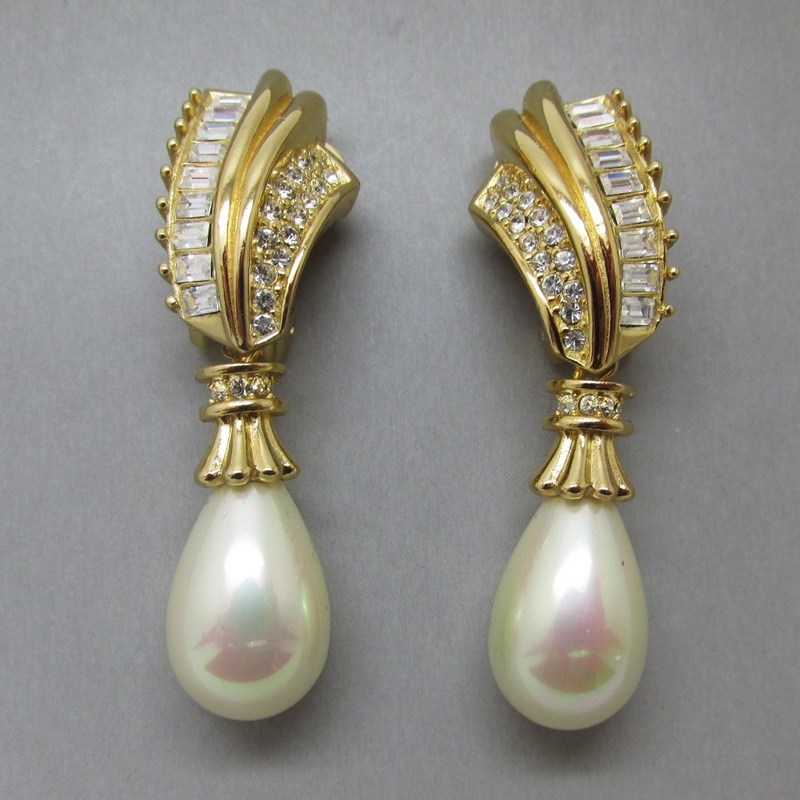Sale 10 % Off. Enter code NEW10 at checkout. (Add item to cart, click on black cart icon, then "VIEW CART", then "Use Coupon Code").
The Complete Guide to Costume Jewellery
What is Costume Jewellery?
The phrase costume jewellery was first used in the 1920s, however jewellery and ornamentation
made out of non-precious materials have been worn since ancient times. While it is sometimes
called fake or "fashion" jewellery, it often incorporates workmanship and materials on a par with,
or even better than fine jewellery.
The 20th century resulted in a sea change as to how jewellery was perceived and used. Before then,
women wore jewellery made of precious and semi-precious stones and metals as a way of flaunting
the wealth of their families and husbands. Therefore, jewellery was mostly worn by the upper classes
to convey their position in society, although it could also symbolize one's religion, the state of a
romance, or a time of mourning.
New Inexpensive Materials for Costume Jewellery
However early in the 20th century, due to the development of new materials and industrialization,
fashion designers began to experiment with jewellery as an expression of style and creativity,
using less expensive non precious materials so that pieces could be larger and bolder, in line
with the Art Deco style and flapper girl fashions that were emerging. Because these
necklaces,earrings,and brooches were made of inexpensive materials and not designed
to be keepsakes or heirlooms, they could be more outrageous and trendy, thrown out or
replaced when a particular look went out of fashion.
The Creation of Diamante Glass Jewellery
The beginning of this movement can be traced to the 17th and 18th centuries, when Europe's
collective desire for precious gemstones, in particular diamonds, prompted many jewellers to
search for more affordable substitutes in glass. In 1724, a young jeweller named Georges Frédéric
Strass created a special leaded glass known as paste that could be cut and polished with metal
powder so that itappeared to twinkle like a diamond in candlelight. Before long, his diamante creations
were very popular in Parisian society.
Swarovski and the Creation of Crystal Rhinestones
Due to the influence of Queen Victoria and her tragic romance, 19th-century ladies took to wearingjewellery made from non-precious materials such as paste, mirrored-back glass, and black jet for
particular, sentimental reasons such as mourning or romance. Then, in 1892, Austrian jeweller
Daniel Swarovski created his coveted fine crystal rhinestones created with high-lead-content glass
and a permanent foil backing. This allowed the rhinestones to imitate the facets and lustre of
gemstones, from rubies and diamonds, sapphires and emeralds.
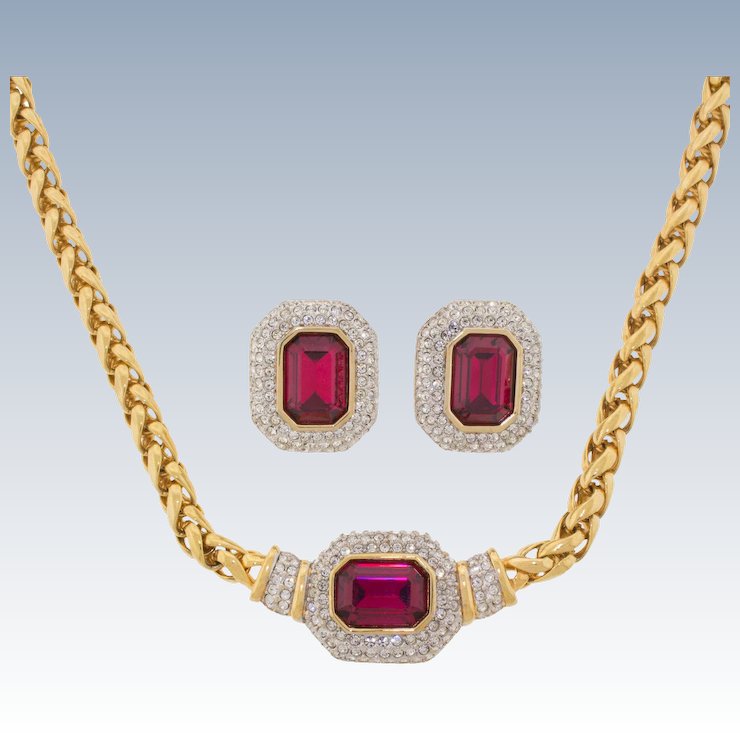
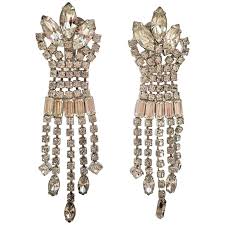
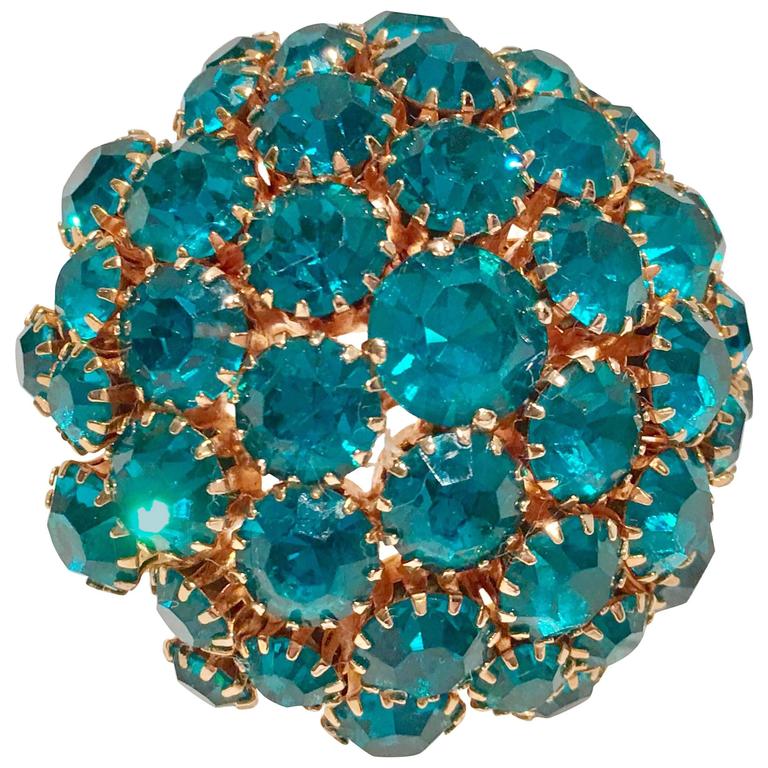
L to R: Swarovksi faux ruby necklace, clear crystal earrings, and teal crystal brooch
Statement Accessories
However the concept of costume jewellery, per se, wasn't really introduced until the latter partof the 1920s, when Coco Chanel launched a line of strong statement accessories. Made to
resemble large flowers or frogs, these items were meant to be worn like art rather than as
indicators of wealth. Her jewellery was very different from anything that had come before and
it was a great hit. Taking inspiration from this, Elsa Schiaparelli produced a line of jewellery
with large faux stones on bold bracelets whose designs were inspired by the Dada art movement.
Bakelite Plastic Resin
Much of this new jewellery was made out of a new hard plastic material called Bakelite, a plasticresin created by Leo Baekeland in 1907. Bakelite could be produced in several bright colours,
which were given quirky names like Apple Juice, Salmon and Butterscotch. Extremely popular
in the 1930s and 1940s, Bakelite was hard enough to be polished and carved into all sorts of
intriguing shapes forbangle and beads.
The fashion for big, angular, and chunky bangles started with the late 20s flappers, who would
pile them along their slender and scandalously bare arms. Initially made of ivory, the bangles
fashion, which endured well into the 60s, soon became dominated by new brightly coloured
plastics like Bakelite and Lucite.
Even more abstract jewellery emerged from the art movements of 30s and 40s. Influenced
by Bauhaus, Cubism, Futurism, and Abstract Expressionism, as well as the new industrialization
, designers produced heavy, armour-like cocktail jewellery using gilt metal, chrome or large
stones reflecting the rhythm and movement of an assembly line. Some of these pieces were
meant to resemble screw-heads,ball bearings, nuts, and bolts.
Top Costume Jewellers and Fine Jewellery Imitations
At the same time, other top costume jewellers such as Eisenberg, Hobe and Trifari keptthings delicate an dainty making great imitations of fine jewellery like Cartier diamonds
alongside theirown stunning bracelets, necklaces, brooches and earrings.

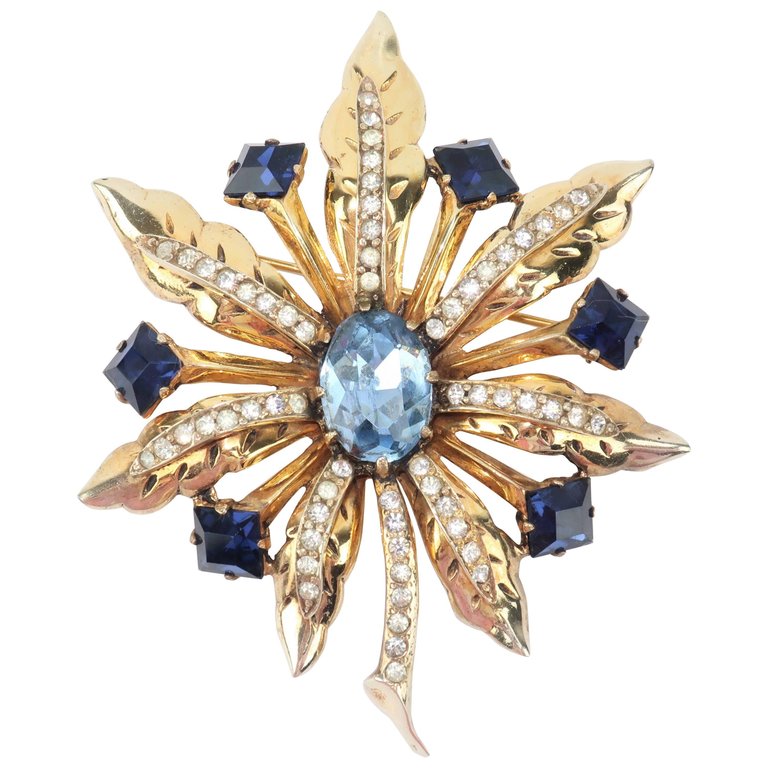

L to R: Eisenberg green crystal brooch, blue crystal flower brooch, and Hobe costume necklace
Fuelling interest in costume jewellery was the emergence of Hollywood as a style trendsetter.
In particular, movie-set jewellery such as Eugene Joseff's creations for Casablanca,
Gone With The Wind and The Wizard of Oz, which resembled expensive gems, were highly
influential. Even Marilyn Monroe, Greta Garbo, and Joan Crawford made public appearances
wearing stunning rhinestone necklaces, while First Lady Mamie Eisenhower wore costume
jewellery for her husband's inaugural ball .
Dior Costume Jewellery
Beginning in the late '40s, high-end Parisian designers like Christian Dior started producing
costume jewellery. Dior was an early fan of Swarovskis aurora borealis rhinestones, which
were developed and introduced in 1955 with an extra dimension of sparkle thanks to a chemical
treatment that iridized the glass.
Alfred Philippe, trained as a fine jeweller at Van Cleef & Arpels, was one of the foremost innovators
in costume jewellery during his period as Trifaris chief designer from 1930 to 1968. He brought
his particular invisible-setting technique to smoothed non-precious stones known as cabochons,
often incorporated into the very popular Trifari Crown pins.
Jelly Belly Animal Brooches
it was a seal, poodle, rooster or duckling featured a Lucite plastic belly smoothed into a pearl-like
shape,set in gold plate or sterling silver. These pins, which were imitated by Coro and others, are
highly collectible and prized today, as are Trifaris brooches. They are often exact matches of
Cartier fine jewellery shaped into floral designs, miniature fruits, and American flags.
Miriam Haskell Floral Jewellery
Around the same time, Miriam Haskell produced intricate hand-crafted floral jewellery that was
very popular within the Manhattan socialite scene and loved by Hollywood stars like Lucille
all and Joan Craword. Her high-quality pieces featured gilt filigree, Swarovski crystal beads,
Murano blown-glass beads, faux pearls, and rose montées,
These were precut crystals mounted onto a silver setting with a channel or hole in the back.
Eisenberg & Sons were also noted for their great quality costume jewellery, particularly their
reproductions of 18th century fine jewels and the figural rhinestone items set in sterling silver.
Even fine jeweller Emanuel Ciner progressed to costume jewellery in the 1930s, producing
the greatest hand-crafted pieces .Ciner incorporated Swarovski crystals and plated the
metal that held the crystals in places with 18-carat gold. Interlocking crystal squares were a
feature of Ciner costume jewellery, as were very small turquoise seed pearls, and also
Japanese faux pearls made of glass treated multiple times with a special glaze.
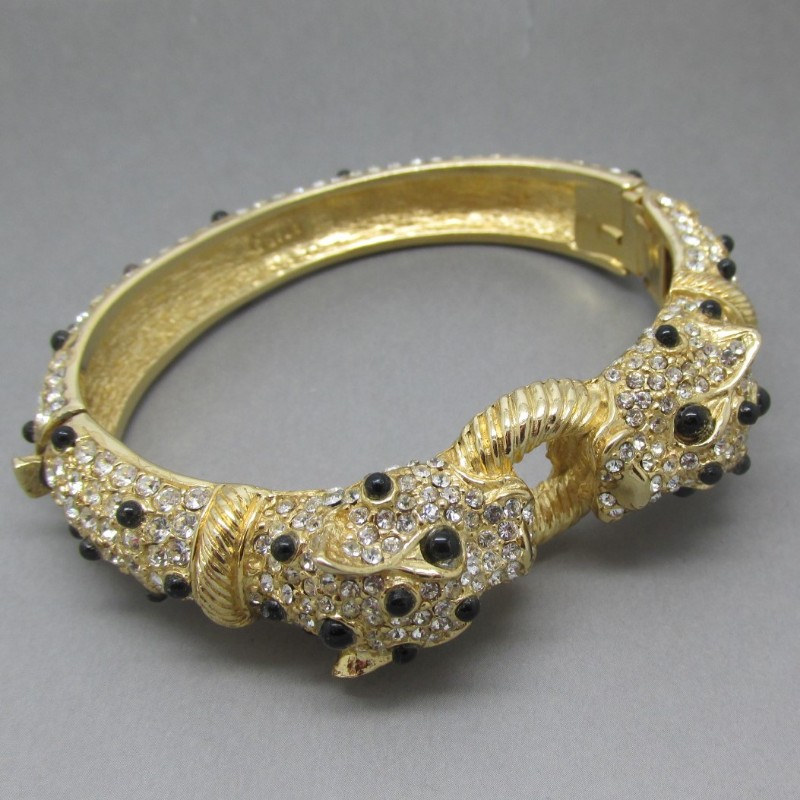
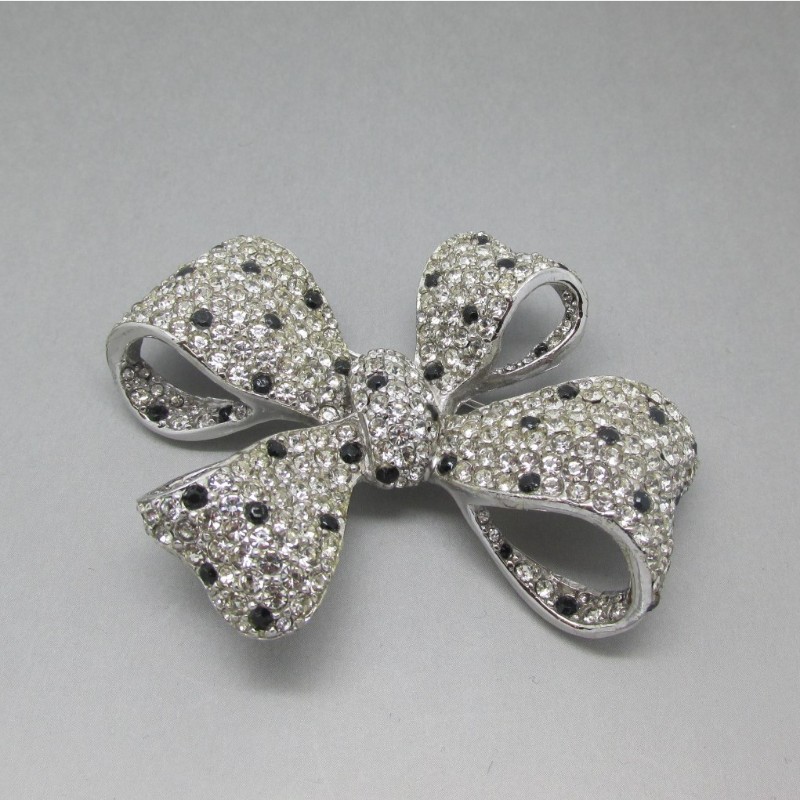
Ciner panther bracelet and crystal bow brooch from Modern Vintage Style
Designer American Cocktail Jewellery
The Second World War had a great impact on American Jewellery firms, as by the time
the Americans entered the war in 1941 the government had placed restrictions on base
metals which were required for the war effort. This together with a reduction in imported
materials from Europe resulted in jewellers substituting base metals with sterling silver
and using modern materials such as Lucite and other plastics in place of cabochon cut
pastes to create unique jewellery.
When the war finished, Trifari wished to return to inexpensive metals so it promoted its
latest products by calling them Trifanium, which was a basic metal that could incorporate
a no-polish rhodium plating
Yellow Vermeil (Silver Gilt) used in new American look Jewellery Designs
America’s isolation and separation from Europe throughout the war resulted in a lack of
European influence in American jewellery trends, and due to this, the first totally American
look in jewellery design emerged. A particular aspect of this new style was the use of
yellow vermeil, or silver gilt as it is often known.
Fake Ruby and Aquamarine gems, and Large Stones used in "Cocktail Jewellery"
These new jewellery designs often featured large sized stones and strong colour combinations
of fake gems such as bold ruby red against aquamarine. Popular styles were abstracted designs
that looked like drapery, as well as strong sculpted scrolls and bows. These free flowing and
sculptural items were in contrast to the geometric and streamlined pieces of the earlier Art Deco Era.
It became the style to wear this new type of jewellery to cocktail parties and evening events the
result of this was the name “cocktail jewellery” being used for this new jewellery design type.
Big Name Jewellery Firms of the 1940's - Coro and Trifari
The most famous two names in American costume jewellery of the 1940’s were Trifari and Coro.
Both companies had achieved success producing imitations of Art Deco jewellery using inspiration from
the designs of Cartier.
Coro Double Locking Clips and Trifari "Tutti Frutti" Jewellery
Coro was the first firm to manufacture double locking clips that could be worn separately or together .
These clips called “Duettes” were very popular items. Trifari developed good reputation by producing
top quality costume jewellery imitations of tutti frutti jewellery.
Coro angelfish and animal brooches
Coro and Trifari led the way in the design of cocktail jewellery n the 1940’s and early 1950’s and they
moved the style forward in a fun, figurative, and imaginative way. Notable Coro designs of this period
were brooches shaped like anglefish,hands, and donkey carts, while designs by Trifari often featured
animal brooches made with Lucite
Swarovski Aurora Borealis Rhinestone
In the middle part of the 1950’s Swarovski designed a special rhinestone for Christian Dior.
The new rhinestone design was called “aurora borealis” with regard to the northern lights.
This new design was also used by the New York jewellers Weiss to produce a range of jewellery
for evening wear which became extremely influential. The aurora borealis designs by Weiss
were of high quality and the firm received mucch accolade for their work
1950's Parure sets, with Necklaces, Earrings and Brooches
In the conservative 50s, a period when matching sweater sets were considered proper,
women wanted their jewellery to match also, therefore costume jewellery was produced
in parures, with matching necklaces, earrings, brooches and sometimes bracelets.
These jewellery sets are technically demi-parures, as they are not big enough to be
considered a full suite of jewellery.
The 50s and 60s also saw a revival in the Victorian Era charm bracelet, a fashion made
popular by Jacqueline Kennedy and Elizabeth Taylor. Naturally, costume jewellers got in on
the charm-making business, as women and young girls would add charms and lockets to their
bracelets to signify particular moments in their lives.
As things turned out, given the detailed craftsmanship and artistry put into costume
jewellery, nowadays most people do not consider it junk at all, and many of the jewellery
pieces, are now highly treasured by collectors.
The Market for Costume and Fine Vintage Necklaces
When a 1925 Cartier vintage necklace set with diamonds and rubies came up for auctionin Hong Kong in the year 1994, it went unsold. However, nineteen years later, the same
vintage necklace fetched more than twice the earlier estimate, selling for HK$4.82m to a
select private collector.
The sparkling gems in the necklace were set in a classic art deco style, designed by a very
renowned French jewellery house. However despite the necklace’s provenance, the experts
say that demand for such pieces, particularly in China, did not even exist 20 years ago.
In the past ten years however, interest from the Asian market in antique and vintage costume
jewellery has gathered speed, partly because buyers have thrown off supposed superstition
about pre-owned pieces and also because such necklaces and earrings makes an attractive
proposition for investors.
Buyers are eyeing a range of periods and style – from antique through to art deco and right
up to designs of the 1990s by JAR (Joel Arthur Rosenthal), the exclusive and Paris-based
jeweller. Pieces of known provenance are particularly sought after. At a Hong Kong auction in April,
the Cartier Collection, the famous jeweller’s heritage archive, paid $27.44m for a jadeite
necklace that was the subject of a 20-minute bidding war. The growing trend for buying quality
vintage necklaces as opposed to newer jewellery is now seen in a younger generation of buyer.
These are buyers who may have inherited jewellery, and are paying attention to period pieces.
Owning a special unique piece has a cachet – whoever is wearing the vintage necklace
,vintage brooch or earrings knows they will not bump into somebody else wearing the same
piece. And limited availability for vintage jewellery always enhances the value. Particular
stones are alsopopular with aquamarine and amethyst being a favourite
An appreciation of the workmanship that goes into vintage jewellery is driving demand. Period
pieceswill be handmade from beginning to end, which is not always the case with more modern
jewellery where computers are often used for precise cutting.
Classic Pearl and Gold and Silver Vintage Necklaces Always in Demand
Vintage necklaces are particularly in demand. Whether it’s classic pearl necklaces, long
gold and silver designer vintage necklaces or more costume jewellery necklaces the vintage
market has never been busier. Glitzy vintage costume jewellery necklaces are always popular
with some of the vintage necklaces from the big brands of recent decades, such as Trifari,Coro,
Butler and Wilson, Monet , being most sought after.
Miriam Haskell Vintage Pearl Necklaces
In years gone past in Hollywood the big starts such as Joan Crawford were fans of costumejewellery necklaces from early on. Joan Crawford was a regular client of acclaimed costume
jewellery designer Miriam Haskell. Vintage Haskell necklaces are among the popular designer’s
most sought-after pieces. Some necklaces have only a single strand of faux pearls. Others have
multiple pearl strands in matching or different sizes and colours—from traditional white to smouldering
dark brown. Even the necklace clasps are opportunities for embellishment, with rose montées, pearls,
and filigree decorating the ends of the clasps.
Faux Pearl, Gemstone and Rhinestone Crystal Necklaces worn by old Hollywood stars
Famous designer Coco Chanel was another admirer of costume necklaces, providing faux-pearl andglass-bead necklaces to such stars as Elizabeth Taylor. After World War II, Christian Dior combined
fauxemeralds or rubies with sparkling rhinestones. Greta Garbo, Claudette Colbert, and Vivian Leigh
are just some of the other influential movie stars who routinely wore sparkling costume necklaces.
One particular designer whose main focus was Hollywood was Eugene Joseff. His company, Joseff of
Hollywood, made stunning costume jewellery necklaces for such films as “A Star is Born” (1936), and
“Casablanca” (1942). In that Alfred Hitchcock classic film Grace Kelly wore a Joseff necklace with a
spectacular strand of faux diamonds.
1950's Costume Jewellery - Trifari Jewellery
By the 1950’s costume jewellery necklaces had become so admired that Mamie Eisenhower felt
perfectly at ease wearing a Trifari costume jewellery necklace to the inaugural ball in 1953.
To match the First Lady’s pink gown (dripping with sparkling rhinestones), Trifari’s Alfred
Philippe produced an "orientique" pearl choker with matching three-strand bracelet and earrings
each with eight pearls. Three sets of this jewellery were made: one for the First Lady, a second
for the Smithsonian Museum, and a third for the Trifari company archives. Mrs. Eisenhower was
so pleased with the result that she had Trifari make a parure of jewellery for another inaugural ball
in 1957. Other very collectible vintage costume jewellery necklaces include Coro’s Vendome
rhinestone-studdedchokers, Elsa Schiaparelli’s bright pink lava-rock necklace collars, and Stanley
Hagler’s coral floral type necklaces.
For more information on top brands see our article The Ultimate Guide to European Costume Brands



